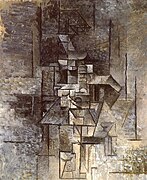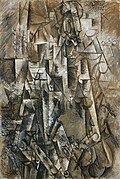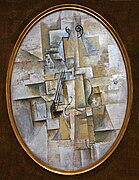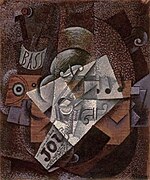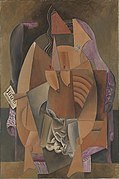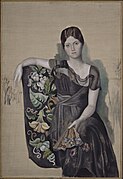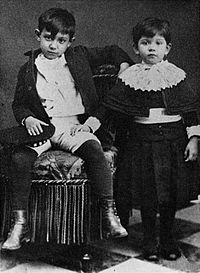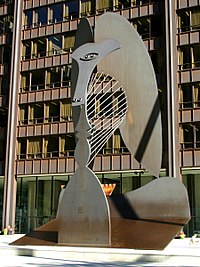
Pablo Picasso
Jump to navigationJump to search
|
Pablo Picasso
|
|
|---|---|
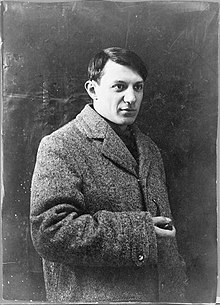
Picasso in 1908
|
|
| Born |
Pablo Diego José Francisco de Paula Juan Nepomuceno María de los Remedios Cipriano de la Santísima Trinidad Ruiz y Picasso[1]
25 October 1881 |
| Died | 8 April 1973 (aged 91)
Mougins, France
|
| Resting place | Château of Vauvenargues 43.554142°N 5.604438°E |
| Nationality | Spanish |
| Education | José Ruiz y Blasco (father) Real Academia de Bellas Artes de San Fernando |
| Known for | Painting, drawing, sculpture, printmaking, ceramics, stage design, writing |
|
Notable work
|
La Vie (1903) Family of Saltimbanques (1905) Les Demoiselles d’Avignon (1907) Portrait of Daniel-Henry Kahnweiler (1910) Girl before a Mirror (1932) Le Rêve (1932) Guernica (1937) The Weeping Woman (1937) |
| Movement | Cubism, Surrealism |
| Spouse(s) |
Olga Khokhlova
(m. 1918; d. 1955) Jacqueline Roque
(m. 1961) |
| Partner(s) | Marie-Thérèse Walter Dora Maar Françoise Gilot |
| Patron(s) | Sergei Shchukin |
Pablo Ruiz Picasso[a][b] (UK: /ˈpæbloʊ pɪˈkæsoʊ/, US: /ˈpɑːbloʊ pɪˈkɑːsoʊ, –ˈkæs-/,[2][3][4] Spanish: [ˈpaβlo piˈkaso]; 25 October 1881 – 8 April 1973) was a Spanish painter, sculptor, printmaker, ceramicist and theatre designer who spent most of his adult life in France. Regarded as one of the most influential artists of the 20th century, he is known for co-founding the Cubist movement, the invention of constructed sculpture,[5][6] the co-invention of collage, and for the wide variety of styles that he helped develop and explore. Among his most famous works are the proto-Cubist Les Demoiselles d’Avignon (1907), and Guernica (1937), a dramatic portrayal of the bombing of Guernica by German and Italian airforces during the Spanish Civil War.
Picasso demonstrated extraordinary artistic talent in his early years, painting in a naturalistic manner through his childhood and adolescence. During the first decade of the 20th century, his style changed as he experimented with different theories, techniques, and ideas. After 1906, the Fauvist work of the slightly older artist Henri Matisse motivated Picasso to explore more radical styles, beginning a fruitful rivalry between the two artists, who subsequently were often paired by critics as the leaders of modern art.[7][8][9][10]
Picasso’s work is often categorized into periods. While the names of many of his later periods are debated, the most commonly accepted periods in his work are the Blue Period (1901–1904), the Rose Period (1904–1906), the African-influenced Period (1907–1909), Analytic Cubism (1909–1912), and Synthetic Cubism (1912–1919), also referred to as the Crystal period. Much of Picasso’s work of the late 1910s and early 1920s is in a neoclassical style, and his work in the mid-1920s often has characteristics of Surrealism. His later work often combines elements of his earlier styles.
Exceptionally prolific throughout the course of his long life, Picasso achieved universal renown and immense fortune for his revolutionary artistic accomplishments, and became one of the best-known figures in 20th-century art.
Early life
Picasso was baptized Pablo Diego José Francisco de Paula Juan Nepomuceno María de los Remedios Cipriano de la Santísima Trinidad Ruiz y Picasso,[1] a series of names honouring various saints and relatives.[11] Ruiz y Picasso were included for his father and mother, respectively, as per Spanish tradition. Born in the city of Málaga in the Andalusian region of Spain, he was the first child of Don José Ruiz y Blasco (1838–1913) and María Picasso y López.[12] Though baptized a Catholic, Picasso would later become an atheist.[13]
The surname “Picasso” comes from Liguria, a coastal region of north-western Italy; its capital is Genoa.[14] There was a painter from the area named Matteo Picasso (1794–1879), born in Recco (Genoa), of late neoclassical style portraiture,[14] though investigations have not definitively determined his kinship with the branch of ancestors related to Pablo Picasso. The direct branch from Sori, Liguria (Genoa), can be traced back to Tommaso Picasso (1728–1813). His son Giovanni Battista, married to Isabella Musante, was Pablo’s great-great-grandfather. Of this marriage was born Tommaso (Sori, 1787–Málaga, 1851). Pablo’s maternal great-grandfather, Tommaso Picasso moved to Spain around 1807.[14]
Picasso’s family was of middle-class background. His father was a painter who specialized in naturalistic depictions of birds and other game. For most of his life, Ruiz was a professor of art at the School of Crafts and a curator of a local museum. Ruiz’s ancestors were minor aristocrats.
Picasso showed a passion and a skill for drawing from an early age. According to his mother, his first words were “piz, piz”, a shortening of lápiz, the Spanish word for “pencil”.[15] From the age of seven, Picasso received formal artistic training from his father in figure drawing and oil painting. Ruiz was a traditional academic artist and instructor, who believed that proper training required disciplined copying of the masters, and drawing the human body from plaster casts and live models. His son became preoccupied with art to the detriment of his classwork.
The family moved to A Coruña in 1891, where his father became a professor at the School of Fine Arts. They stayed almost four years. On one occasion, the father found his son painting over his unfinished sketch of a pigeon. Observing the precision of his son’s technique, an apocryphal story relates, Ruiz felt that the thirteen-year-old Picasso had surpassed him, and vowed to give up painting,[16] though paintings by him exist from later years.
In 1895, Picasso was traumatized when his seven-year-old sister, Conchita, died of diphtheria.[17] After her death, the family moved to Barcelona, where Ruiz took a position at its School of Fine Arts. Picasso thrived in the city, regarding it in times of sadness or nostalgia as his true home.[18] Ruiz persuaded the officials at the academy to allow his son to take an entrance exam for the advanced class. This process often took students a month, but Picasso completed it in a week, and the jury admitted him, at just 13. As a student, Picasso lacked discipline but made friendships that would affect him in later life. His father rented a small room for him close to home so he could work alone, yet he checked up on him numerous times a day, judging his drawings. The two argued frequently.[19]
Picasso’s father and uncle decided to send the young artist to Madrid’s Real Academia de Bellas Artes de San Fernando, the country’s foremost art school.[18] At age 16, Picasso set off for the first time on his own, but he disliked formal instruction and stopped attending classes soon after enrollment. Madrid held many other attractions. The Prado housed paintings by Diego Velázquez, Francisco Goya, and Francisco Zurbarán. Picasso especially admired the works of El Greco; elements such as his elongated limbs, arresting colours, and mystical visages are echoed in Picasso’s later work.[20]
Career
Before 1900

Picasso in 1904. Photograph by Ricard Canals.
Picasso’s training under his father began before 1890. His progress can be traced in the collection of early works now held by the Museu Picasso in Barcelona, which provides one of the most comprehensive records extant of any major artist’s beginnings.[21] During 1893 the juvenile quality of his earliest work falls away, and by 1894 his career as a painter can be said to have begun.[22] The academic realism apparent in the works of the mid-1890s is well displayed in The First Communion (1896), a large composition that depicts his sister, Lola. In the same year, at the age of 14, he painted Portrait of Aunt Pepa, a vigorous and dramatic portrait that Juan-Eduardo Cirlot has called “without a doubt one of the greatest in the whole history of Spanish painting.”[23]
In 1897, his realism began to show a Symbolist influence, for example, in a series of landscape paintings rendered in non-naturalistic violet and green tones. What some call his Modernist period (1899–1900) followed. His exposure to the work of Rossetti, Steinlen, Toulouse-Lautrec and Edvard Munch, combined with his admiration for favourite old masters such as El Greco, led Picasso to a personal version of modernism in his works of this period.[24]
Picasso made his first trip to Paris, then the art capital of Europe, in 1900. There, he met his first Parisian friend, journalist and poet Max Jacob, who helped Picasso learn the language and its literature. Soon they shared an apartment; Max slept at night while Picasso slept during the day and worked at night. These were times of severe poverty, cold, and desperation. Much of his work was burned to keep the small room warm. During the first five months of 1901, Picasso lived in Madrid, where he and his anarchist friend Francisco de Asís Soler founded the magazine Arte Joven (Young Art), which published five issues. Soler solicited articles and Picasso illustrated the journal, mostly contributing grim cartoons depicting and sympathizing with the state of the poor. The first issue was published on 31 March 1901, by which time the artist had started to sign his work Picasso.[25] From 1898 he signed his works as “Pablo Ruiz Picasso”, then as “Pablo R. Picasso” until 1901. The change does not seem to imply a rejection of the father figure. Rather, he wanted to distinguish himself from others; initiated by his Catalan friends who habitually called him by his maternal surname, much less current than the paternal Ruiz.[26]
Blue Period: 1901–1904
Picasso’s Blue Period (1901–1904), characterized by sombre paintings rendered in shades of blue and blue-green, only occasionally warmed by other colours, began either in Spain in early 1901, or in Paris in the second half of the year.[27] Many paintings of gaunt mothers with children date from the Blue Period, during which Picasso divided his time between Barcelona and Paris. In his austere use of colour and sometimes doleful subject matter – prostitutes and beggars are frequent subjects – Picasso was influenced by a trip through Spain and by the suicide of his friend Carles Casagemas. Starting in autumn of 1901 he painted several posthumous portraits of Casagemas, culminating in the gloomy allegorical painting La Vie (1903), now in the Cleveland Museum of Art.[28]
The same mood pervades the well-known etching The Frugal Repast (1904),[29] which depicts a blind man and a sighted woman, both emaciated, seated at a nearly bare table. Blindness is a recurrent theme in Picasso’s works of this period, also represented in The Blindman’s Meal (1903, the Metropolitan Museum of Art) and in the portrait of Celestina (1903). Other Blue Period works include Portrait of Soler and Portrait of Suzanne Bloch.
Rose Period: 1904–1906

Pablo Picasso, 1905, Au Lapin Agile (At the Lapin Agile) (Arlequin tenant un verre), oil on canvas, 99.1 × 100.3 cm, Metropolitan Museum of Art
The Rose Period (1904–1906)[30] is characterized by a lighter tone and style utilizing orange and pink colours, and featuring many circus people, acrobats and harlequins known in France as saltimbanques. The harlequin, a comedic character usually depicted in checkered patterned clothing, became a personal symbol for Picasso. Picasso met Fernande Olivier, a bohemian artist who became his mistress, in Paris in 1904.[17] Olivier appears in many of his Rose Period paintings, many of which are influenced by his warm relationship with her, in addition to his increased exposure to French painting. The generally upbeat and optimistic mood of paintings in this period is reminiscent of the 1899–1901 period (i.e. just prior to the Blue Period) and 1904 can be considered a transition year between the two periods.

Portrait of Gertrude Stein, 1906, Metropolitan Museum of Art, New York City. When someone commented that Stein did not look like her portrait, Picasso replied, “She will”.[31]
By 1905, Picasso became a favourite of American art collectors Leo and Gertrude Stein. Their older brother Michael Stein and his wife Sarah also became collectors of his work. Picasso painted portraits of both Gertrude Stein and her nephew Allan Stein. Gertrude Stein became Picasso’s principal patron, acquiring his drawings and paintings and exhibiting them in her informal Salon at her home in Paris.[32] At one of her gatherings in 1905, he met Henri Matisse, who was to become a lifelong friend and rival. The Steins introduced him to Claribel Cone and her sister Etta who were American art collectors; they also began to acquire Picasso and Matisse’s paintings. Eventually Leo Stein moved to Italy. Michael and Sarah Stein became patrons of Matisse, while Gertrude Stein continued to collect Picasso.[33]
In 1907, Picasso joined an art gallery that had recently been opened in Paris by Daniel-Henry Kahnweiler. Kahnweiler was a German art historian and art collector who became one of the premier French art dealers of the 20th century. He was among the first champions of Pablo Picasso, Georges Braque and the Cubism that they jointly developed. Kahnweiler promoted burgeoning artists such as André Derain, Kees van Dongen, Fernand Léger, Juan Gris, Maurice de Vlaminck and several others who had come from all over the globe to live and work in Montparnasse at the time.[34]
African art and primitivism: 1907–1909
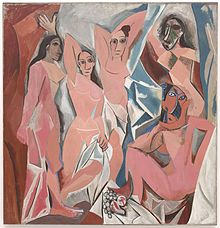
Les Demoiselles d’Avignon (1907), Museum of Modern Art, New York
Picasso’s African-influenced Period (1907–1909) begins with his painting Les Demoiselles d’Avignon. Picasso painted this composition in a style inspired by Iberian sculpture, but repainted the faces of the two figures on the right after being powerfully impressed by African artefacts he saw in June 1907 in the ethnographic museum at Palais du Trocadéro.[35] When he displayed the painting to acquaintances in his studio later that year, the nearly universal reaction was shock and revulsion; Matisse angrily dismissed the work as a hoax.[36] Picasso did not exhibit Le Demoiselles publicly until 1916.
Other works from this period include Nude with Raised Arms (1907) and Three Women (1908). Formal ideas developed during this period lead directly into the Cubist period that follows.
Analytic cubism: 1909–1912
Analytic cubism (1909–1912) is a style of painting Picasso developed with Georges Braque using monochrome brownish and neutral colours. Both artists took apart objects and “analyzed” them in terms of their shapes. Picasso and Braque’s paintings at this time share many similarities.
In Paris, Picasso entertained a distinguished coterie of friends in the Montmartre and Montparnasse quarters, including André Breton, poet Guillaume Apollinaire, writer Alfred Jarry and Gertrude Stein. In 1911, Picasso was arrested and questioned about the theft of the Mona Lisa from the Louvre. Suspicion for the crime had initially fallen upon Apollinaire due to his links to Géry Pieret, an artist with a history of thefts from the gallery. Apollinaire in turn implicated his close friend Picasso, who had also purchased stolen artworks from the artist in the past. Afraid of a conviction that could result in his deportation to Spain, Picasso denied having ever met Apollinaire. Both were later cleared of any involvement in the painting’s disappearance.[37][38]
Synthetic cubism: 1912–1919

Picasso in front of his painting The Aficionado (Kunstmuseum Basel) at Villa les Clochettes, summer 1912
Synthetic cubism (1912–1919) was a further development of the genre of cubism, in which cut paper fragments – often wallpaper or portions of newspaper pages – were pasted into compositions, marking the first use of collage in fine art.
Between 1915 and 1917, Picasso began a series of paintings depicting highly geometric and minimalist Cubist objects, consisting of either a pipe, a guitar or a glass, with an occasional element of collage. “Hard-edged square-cut diamonds”, notes art historian John Richardson, “these gems do not always have upside or downside”.[39][40] “We need a new name to designate them,” wrote Picasso to Gertrude Stein: Maurice Raynal suggested “Crystal Cubism“.[39][41] These “little gems” may have been produced by Picasso in response to critics who had claimed his defection from the movement, through his experimentation with classicism within the so-called return to order following the war.[39][42]
After acquiring some fame and fortune, Picasso left Olivier for Marcelle Humbert, whom he called Eva Gouel. Picasso included declarations of his love for Eva in many Cubist works. Picasso was devastated by her premature death from illness at the age of 30 in 1915.[43]
At the outbreak of World War I in August 1914, Picasso was living in Avignon. Braque and Derain were mobilized and Apollinaire joined the French artillery, while the Spaniard Juan Gris remained from the Cubist circle. During the war, Picasso was able to continue painting uninterrupted, unlike his French comrades. His paintings became more sombre and his life changed with dramatic consequences. Kahnweiler’s contract had terminated on his exile from France. At this point Picasso’s work would be taken on by the art dealer Léonce Rosenberg. After the loss of Eva Gouel, Picasso had an affair with Gaby Lespinasse. During the spring of 1916, Apollinaire returned from the front wounded. They renewed their friendship, but Picasso began to frequent new social circles.[44]

Costume design by Pablo Picasso representing skyscrapers and boulevards, for Serge Diaghilev‘s Ballets Russes performance of Parade at Théâtre du Châtelet, Paris 18 May 1917
Towards the end of World War I, Picasso became involved with Serge Diaghilev‘s Ballets Russes. Among his friends during this period were Jean Cocteau, Jean Hugo, Juan Gris, and others. In the summer of 1918, Picasso married Olga Khokhlova, a ballerina with Sergei Diaghilev’s troupe, for whom Picasso was designing a ballet, Erik Satie’s Parade, in Rome; they spent their honeymoon near Biarritz in the villa of glamorous Chilean art patron Eugenia Errázuriz.

Pablo Picasso and scene painters sitting on the front cloth for Léonide Massine‘s ballet Parade, staged by Sergei Diaghilev‘s Ballets Russes at the Théâtre du Châtelet, Paris, 1917
After returning from his honeymoon and in need of money, Picasso started his exclusive relationship with the French-Jewish art dealer Paul Rosenberg. As part of his first duties, Rosenberg agreed to rent the couple an apartment in Paris at his own expense, which was located next to his own house. This was the start of a deep brother-like friendship between two very different men, that would last until the outbreak of World War II.
Khokhlova introduced Picasso to high society, formal dinner parties, and other dimensions of the life of the rich in 1920s Paris. The two had a son, Paulo Picasso,[45] who would grow up to be a motorcycle racer and chauffeur to his father. Khokhlova’s insistence on social propriety clashed with Picasso’s bohemian tendencies and the two lived in a state of constant conflict. During the same period that Picasso collaborated with Diaghilev’s troupe, he and Igor Stravinsky collaborated on Pulcinella in 1920. Picasso took the opportunity to make several drawings of the composer.[46]
In 1927, Picasso met 17-year-old Marie-Thérèse Walter and began a secret affair with her. Picasso’s marriage to Khokhlova soon ended in separation rather than divorce, as French law required an even division of property in the case of divorce, and Picasso did not want Khokhlova to have half his wealth. The two remained legally married until Khokhlova’s death in 1955. Picasso carried on a long-standing affair with Marie-Thérèse Walter and fathered a daughter with her, named Maya. Marie-Thérèse lived in the vain hope that Picasso would one day marry her, and hanged herself four years after Picasso’s death.
-
1909, Femme assise (Sitzende Frau), oil on canvas, 100 × 80 cm, Staatliche Museen, Neue Nationalgalerie, Berlin
-
1909–10, Figure dans un Fauteuil (Seated Nude, Femme nue assise), oil on canvas, 92.1 × 73 cm, Tate Modern, London. This painting from the collection of Wilhelm Uhde was confiscated by the French state and sold at the Hôtel Drouot in 1921
-
1910, Girl with a Mandolin (Fanny Tellier), oil on canvas, 100.3 × 73.6 cm, Museum of Modern Art, New York
-
1910, Portrait of Daniel-Henry Kahnweiler, The Art Institute of Chicago. Picasso wrote of Kahnweiler “What would have become of us if Kahnweiler hadn’t had a business sense?”
-
c.1911, Le Guitariste. Reproduced in Albert Gleizes and Jean Metzinger, Du “Cubisme”, 1912
-
1911, Still Life with a Bottle of Rum, oil on canvas, 61.3 × 50.5 cm, Metropolitan Museum of Art, New York
-
1911–12, Violon (Violin), oil on canvas, 100 × 73 cm (oval), Kröller-Müller Museum, Otterlo, Netherlands. This painting from the collection of Wilhelm Uhde was confiscated by the French state and sold at the Hôtel Drouot in 1921
-
1913, Bouteille, clarinet, violon, journal, verre, 55 × 45 cm. This painting from the collection of Wilhelm Uhde was confiscated by the French state and sold at the Hôtel Drouot in 1921
-
1913, Femme assise dans un fauteuil (Eva), Woman in a Chemise in an Armchair, oil on canvas, 149.9 × 99.4 cm, Leonard A. Lauder Cubist Collection, Metropolitan Museum of Art
-
1913–14, Head (Tête), cut and pasted coloured paper, gouache and charcoal on paperboard, 43.5 × 33 cm, Scottish National Gallery of Modern Art, Edinburgh
-
1913–14, L’Homme aux cartes (Card Player), oil on canvas, 108 × 89.5 cm, Museum of Modern Art, New York
-
1914–15, Nature morte au compotier (Still Life with Compote and Glass), oil on canvas, 63.5 × 78.7 cm (25 × 31 in), Columbus Museum of Art, Ohio
-
1916, L’anis del mono (Bottle of Anis del Mono), oil on canvas, 46 × 54.6 cm, Detroit Institute of Arts, Michigan
-
Parade, 1917, curtain designed for the ballet Parade. The work is the largest of Picasso’s paintings. Centre Pompidou-Metz, Metz, France, May 2012
Neoclassicism and surrealism: 1919–1929

Pablo Picasso, 1921, Nu assis s’essuyant le pied (Seated Nude Drying her Foot), pastel, 66 x 50.8 cm, Berggruen Museum
In February 1917, Picasso made his first trip to Italy.[47] In the period following the upheaval of World War I, Picasso produced work in a neoclassical style. This “return to order” is evident in the work of many European artists in the 1920s, including André Derain, Giorgio de Chirico, Gino Severini, Jean Metzinger, the artists of the New Objectivity movement and of the Novecento Italiano movement. Picasso’s paintings and drawings from this period frequently recall the work of Raphael and Ingres.
In 1925 the Surrealist writer and poet André Breton declared Picasso as ‘one of ours’ in his article Le Surréalisme et la peinture, published in Révolution surréaliste. Les Demoiselles was reproduced for the first time in Europe in the same issue. Yet Picasso exhibited Cubist works at the first Surrealist group exhibition in 1925; the concept of ‘psychic automatism in its pure state’ defined in the Manifeste du surréalisme never appealed to him entirely. He did at the time develop new imagery and formal syntax for expressing himself emotionally, “releasing the violence, the psychic fears and the eroticism that had been largely contained or sublimated since 1909”, writes art historian Melissa McQuillan.[48] Although this transition in Picasso’s work was informed by Cubism for its spatial relations, “the fusion of ritual and abandon in the imagery recalls the primitivism of the Demoiselles and the elusive psychological resonances of his Symbolist work”, writes McQuillan.[48] Surrealism revived Picasso’s attraction to primitivism and eroticism.[48]
-
Pablo Picasso, 1918, Pierrot, oil on canvas, 92.7 × 73 cm, Museum of Modern Art, New York
-
Pablo Picasso, 1919, Sleeping Peasants, gouache, watercolor and pencil on paper, 31.1 × 48.9 cm, Museum of Modern Art
-
Portrait d’Olga dans un fauteuil (Olga in an Armchair), 1918, Musée Picasso, Paris, France
The Great Depression to MoMA exhibition: 1930–1939
During the 1930s, the minotaur replaced the harlequin as a common motif in his work. His use of the minotaur came partly from his contact with the surrealists, who often used it as their symbol, and it appears in Picasso’s Guernica. The minotaur and Picasso’s mistress Marie-Thérèse Walter are heavily featured in his celebrated Vollard Suite of etchings.[49]
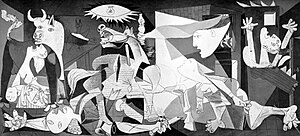
Guernica, 1937, Museo Reina Sofia
Arguably Picasso’s most famous work is his depiction of the German bombing of Guernica during the Spanish Civil War – Guernica. This large canvas embodies for many the inhumanity, brutality and hopelessness of war. Asked to explain its symbolism, Picasso said, “It isn’t up to the painter to define the symbols. Otherwise it would be better if he wrote them out in so many words! The public who look at the picture must interpret the symbols as they understand them.”[50][51] Guernica was exhibited in July 1937 at the Spanish Pavilion at the Paris International Exposition, and then became the centerpiece of an exhibition of 118 works by Picasso, Matisse, Braque and Henri Laurens that toured Scandinavia and England. After the victory of Francisco Franco in Spain, the painting was sent to the United States to raise funds and support for Spanish refugees. Until 1981 it was entrusted to the Museum of Modern Art (MoMA) in New York City, as it was Picasso’s expressed desire that the painting should not be delivered to Spain until liberty and democracy had been established in the country.
In 1939 and 1940, the Museum of Modern Art in New York City, under its director Alfred Barr, a Picasso enthusiast, held a major retrospective of Picasso’s principal works until that time. This exhibition lionized Picasso, brought into full public view in America the scope of his artistry, and resulted in a reinterpretation of his work by contemporary art historians and scholars.[52] According to Jonathan Weinberg, “Given the extraordinary quality of the show and Picasso’s enormous prestige, generally heightened by the political impact of Guernica … the critics were surprisingly ambivalent”.[53] Picasso’s “multiplicity of styles” was disturbing to one journalist; another described him as “wayward and even malicious”; Alfred Frankenstein‘s review in ARTnews concluded that Picasso was both charlatan and genius.[53]
World War II and late 1940s: 1939–1949
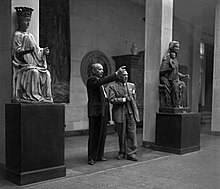
Stanisław Lorentz guides Pablo Picasso through the National Museum in Warsaw in Poland during exhibition Contemporary French Painters and Pablo Picasso’s Ceramics, 1948. Picasso gave Warsaw’s museum over a dozen of his ceramics, drawings and colour prints.[54]
During the Second World War, Picasso remained in Paris while the Germans occupied the city. Picasso’s artistic style did not fit the Nazi ideal of art, so he did not exhibit during this time. He was often harassed by the Gestapo. During one search of his apartment, an officer saw a photograph of the painting Guernica. “Did you do that?” the German asked Picasso. “No,” he replied, “You did”.[55]
Retreating to his studio, he continued to paint, producing works such as the Still Life with Guitar (1942) and The Charnel House (1944–48).[56] Although the Germans outlawed bronze casting in Paris, Picasso continued regardless, using bronze smuggled to him by the French Resistance.[57]
Around this time, Picasso wrote poetry as an alternative outlet. Between 1935 and 1959 he wrote over 300 poems. Largely untitled except for a date and sometimes the location of where it was written (for example “Paris 16 May 1936”), these works were gustatory, erotic and at times scatological, as were his two full-length plays Desire Caught by the Tail (1941) and The Four Little Girls (1949).[58][59]
In 1944, after the liberation of Paris, Picasso, then 63 years old, began a romantic relationship with a young art student named Françoise Gilot. She was 40 years younger than he was. Picasso grew tired of his mistress Dora Maar; Picasso and Gilot began to live together. Eventually they had two children: Claude Picasso, born in 1947 and Paloma Picasso, born in 1949. In her 1964 book Life with Picasso,[60] Gilot describes his abusive treatment and myriad infidelities which led her to leave him, taking the children with her. This was a severe blow to Picasso.

Pablo Picasso photographed in 1953 by Paolo Monti during an exhibition at Palazzo Reale in Milan (Fondo Paolo Monti, BEIC).
Picasso had affairs with women of an even greater age disparity than his and Gilot’s. While still involved with Gilot, in 1951 Picasso had a six-week affair with Geneviève Laporte, who was four years younger than Gilot. By his 70s, many paintings, ink drawings and prints have as their theme an old, grotesque dwarf as the doting lover of a beautiful young model. Jacqueline Roque (1927–1986) worked at the Madoura Pottery in Vallauris on the French Riviera, where Picasso made and painted ceramics. She became his lover, and then his second wife in 1961. The two were together for the remainder of Picasso’s life.
His marriage to Roque was also a means of revenge against Gilot; with Picasso’s encouragement, Gilot had divorced her then husband, Luc Simon, with the plan to marry Picasso to secure the rights of her children as Picasso’s legitimate heirs. Picasso had already secretly married Roque, after Gilot had filed for divorce. His strained relationship with Claude and Paloma was never healed.[61]
By this time, Picasso had constructed a huge Gothic home, and could afford large villas in the south of France, such as Mas Notre-Dame-de-Vie on the outskirts of Mougins, and in the Provence-Alpes-Côte d’Azur. He was an international celebrity, with often as much interest in his personal life as his art.[62]
Later works to final years: 1949–1973

The Chicago Picasso, a 50-foot high public Cubist sculpture. Donated by Picasso to the people of Chicago
Picasso was one of 250 sculptors who exhibited in the 3rd Sculpture International held at the Philadelphia Museum of Art in mid-1949. In the 1950s, Picasso’s style changed once again, as he took to producing reinterpretations of the art of the great masters. He made a series of works based on Velázquez‘s painting of Las Meninas. He also based paintings on works by Goya, Poussin, Manet, Courbet and Delacroix.
In addition to his artistic accomplishments, Picasso made a few film appearances, always as himself, including a cameo in Jean Cocteau’s Testament of Orpheus (1960). In 1955, he helped make the film Le Mystère Picasso (The Mystery of Picasso) directed by Henri-Georges Clouzot.
He was commissioned to make a maquette for a huge 50-foot (15 m)-high public sculpture to be built in Chicago, known usually as the Chicago Picasso. He approached the project with a great deal of enthusiasm, designing a sculpture which was ambiguous and somewhat controversial. What the figure represents is not known; it could be a bird, a horse, a woman or a totally abstract shape. The sculpture, one of the most recognizable landmarks in downtown Chicago, was unveiled in 1967. Picasso refused to be paid $100,000 for it, donating it to the people of the city.
Picasso’s final works were a mixture of styles, his means of expression in constant flux until the end of his life. Devoting his full energies to his work, Picasso became more daring, his works more colourful and expressive, and from 1968 to 1971 he produced a torrent of paintings and hundreds of copperplate etchings. At the time these works were dismissed by most as pornographic fantasies of an impotent old man or the slapdash works of an artist who was past his prime.[63][64] Only later, after Picasso’s death, when the rest of the art world had moved on from abstract expressionism, did the critical community come to see the late works of Picasso as prefiguring Neo-Expressionism.[65]
Pablo Picasso died on 8 April 1973 in Mougins, France from pulmonary edema and heart failure, while he and his wife Jacqueline entertained friends for dinner. He was interred at the Château of Vauvenargues near Aix-en-Provence, a property he had acquired in 1958 and occupied with Jacqueline between 1959 and 1962. Jacqueline Roque prevented his children Claude and Paloma from attending the funeral.[66] Devastated and lonely after the death of Picasso, Jacqueline Roque killed herself by gunshot in 1986 when she was 59 years old.[67]
Political views
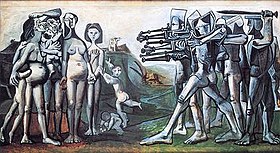
Massacre in Korea, 1951
Picasso remained aloof from the Catalan independence movement during his youth despite expressing general support and being friendly with activists within it. He did not join the armed forces for any side or country during World War I, the Spanish Civil War, and World War II. As a Spanish citizen living in France, Picasso was under no compulsion to fight against the invading Germans in either world war. However, in 1940, he did apply for French citizenship, but it was refused on the grounds of his “extremist ideas evolving towards communism”. This information was not revealed until 2003.[68]
At the start of the Spanish Civil War in 1936, Picasso was 54 years of age. Soon after hostilities began, the Republicans appointed him “director of the Prado, albeit in absentia”, and “he took his duties very seriously”, according to John Richardson, supplying the funds to evacuate the museum’s collection to Geneva.[69] The war provided the impetus for Picasso’s first overtly political work. He expressed anger and condemnation of Francisco Franco and fascists in The Dream and Lie of Franco (1937), which was produced “specifically for propagandistic and fundraising purposes”.[70] This surreal fusion of words and images was intended to be sold as a series of postcards to raise funds for the Spanish Republican cause.[70][71]
In 1944, Picasso joined the French Communist Party, attended the World Congress of Intellectuals in Defense of Peace in Poland, and in 1950 received the Stalin Peace Prize from the Soviet government.[72] Party criticism in 1953 of his portrait of Stalin as insufficiently realistic cooled Picasso’s interest in Soviet politics, though he remained a loyal member of the Communist Party until his death.[69] His dealer, D-H. Kahnweiler, a socialist, termed Picasso’s communism “sentimental” rather than political, saying “He has never read a line of Karl Marx, nor of Engels of course.”[69] In a 1945 interview with Jerome Seckler, Picasso stated: “I am a Communist and my painting is Communist painting. … But if I were a shoemaker, Royalist or Communist or anything else, I would not necessarily hammer my shoes in a special way to show my politics.”[73] His commitment to communism, common among continental intellectuals and artists at the time, has long been the subject of some controversy; a notable demonstration thereof was a quote commonly attributed to Salvador Dalí (with whom Picasso had a rather strained relationship[74]):
- Picasso es pintor, yo también; […] Picasso es español, yo también; Picasso es comunista, yo tampoco.
- (Picasso is a painter, so am I; […] Picasso is a Spaniard, so am I; Picasso is a communist, neither am I.)[75][76][77]
In the late 1940s, his old friend the surrealist poet and Trotskyist[78] and anti-Stalinist André Breton was more blunt; refusing to shake hands with Picasso, he told him: “I don’t approve of your joining the Communist Party nor with the stand you have taken concerning the purges of the intellectuals after the Liberation”.[79] Picasso was against the intervention of the United Nations and the United States in the Korean War and he depicted it in Massacre in Korea.[80][81] The art critic Kirsten Hoving Keen says that it is “inspired by reports of American atrocities” and considers it one of Picasso’s communist works.[82]
In 1962, he received the Lenin Peace Prize.[83] Biographer and art critic John Berger felt his talents as an artist were “wasted” by the communists.[84] According to Jean Cocteau’s diaries, Picasso once said to him in reference to the communists: “I have joined a family, and like all families, it’s full of shit”.[85]
Style and technique
Picasso was exceptionally prolific throughout his long lifetime. The total number of artworks he produced has been estimated at 50,000, comprising 1,885 paintings; 1,228 sculptures; 2,880 ceramics, roughly 12,000 drawings, many thousands of prints, and numerous tapestries and rugs.[86]
The medium in which Picasso made his most important contribution was painting.[87] In his paintings, Picasso used colour as an expressive element, but relied on drawing rather than subtleties of colour to create form and space.[87] He sometimes added sand to his paint to vary its texture. A nanoprobe of Picasso’s The Red Armchair (1931) by physicists at Argonne National Laboratory in 2012 confirmed art historians’ belief that Picasso used common house paint in many of his paintings.[88] Much of his painting was done at night by artificial light.
Picasso’s early sculptures were carved from wood or modelled in wax or clay, but from 1909 to 1928 Picasso abandoned modelling and instead made sculptural constructions using diverse materials.[87] An example is Guitar (1912), a relief construction made of sheet metal and wire that Jane Fluegel terms a “three-dimensional planar counterpart of Cubist painting” that marks a “revolutionary departure from the traditional approaches, modeling and carving”.[89]

Pablo Picasso, 1921, Nous autres musiciens (Three Musicians), oil on canvas, 204.5 x 188.3 cm, Philadelphia Museum of Art
From the beginning of his career, Picasso displayed an interest in subject matter of every kind,[90] and demonstrated a great stylistic versatility that enabled him to work in several styles at once. For example, his paintings of 1917 included the pointillist Woman with a Mantilla, the Cubist Figure in an Armchair, and the naturalistic Harlequin (all in the Museu Picasso, Barcelona). In 1919, he made a number of drawings from postcards and photographs that reflect his interest in the stylistic conventions and static character of posed photographs.[91] In 1921 he simultaneously painted several large neoclassical paintings and two versions of the Cubist composition Three Musicians (Museum of Modern Art, New York; Philadelphia Museum of Art).[47] In an interview published in 1923, Picasso said, “The several manners I have used in my art must not be considered as an evolution, or as steps towards an unknown ideal of painting … If the subjects I have wanted to express have suggested different ways of expression I have never hesitated to adopt them.”[47]
Although his Cubist works approach abstraction, Picasso never relinquished the objects of the real world as subject matter. Prominent in his Cubist paintings are forms easily recognized as guitars, violins, and bottles.[92] When Picasso depicted complex narrative scenes it was usually in prints, drawings, and small-scale works; Guernica (1937) is one of his few large narrative paintings.[91]
Picasso painted mostly from imagination or memory. According to William Rubin, Picasso “could only make great art from subjects that truly involved him … Unlike Matisse, Picasso had eschewed models virtually all his mature life, preferring to paint individuals whose lives had both impinged on, and had real significance for, his own.”[93] The art critic Arthur Danto said Picasso’s work constitutes a “vast pictorial autobiography” that provides some basis for the popular conception that “Picasso invented a new style each time he fell in love with a new woman”.[93] The autobiographical nature of Picasso’s art is reinforced by his habit of dating his works, often to the day. He explained: “I want to leave to posterity a documentation that will be as complete as possible. That’s why I put a date on everything I do.”[93]
Artistic legacy
Picasso’s influence was and remains immense and widely acknowledged by his admirers and detractors alike. On the occasion of his 1939 retrospective at MoMA, Life magazine wrote: “During the 25 years he has dominated modern European art, his enemies say he has been a corrupting influence. With equal violence, his friends say he is the greatest artist alive.”[94] In 1998, Robert Hughes wrote of him: “To say that Pablo Picasso dominated Western art in the 20th century is, by now, the merest commonplace. … No painter or sculptor, not even Michelangelo, had been as famous as this in his own lifetime. … Though Marcel Duchamp, that cunning old fox of conceptual irony, has certainly had more influence on nominally vanguard art over the past 30 years than Picasso, the Spaniard was the last great beneficiary of the belief that the language of painting and sculpture really mattered to people other than their devotees.”[95]

Musée Picasso, Paris (Hotel Salé, 1659)
At the time of Picasso’s death many of his paintings were in his possession, as he had kept off the art market what he did not need to sell. In addition, Picasso had a considerable collection of the work of other famous artists, some his contemporaries, such as Henri Matisse, with whom he had exchanged works. Since Picasso left no will, his death duties (estate tax) to the French state were paid in the form of his works and others from his collection. These works form the core of the immense and representative collection of the Musée Picasso in Paris. In 2003, relatives of Picasso inaugurated a museum dedicated to him in his birthplace, Málaga, Spain, the Museo Picasso Málaga.
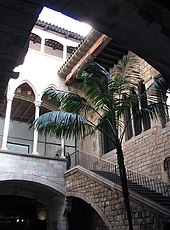
Museu Picasso is located in the gothic palaces of Montcada street in Barcelona
The Museu Picasso in Barcelona features many of his early works, created while he was living in Spain, including many rarely seen works which reveal his firm grounding in classical techniques. The museum also holds many precise and detailed figure studies done in his youth under his father’s tutelage, as well as the extensive collection of Jaime Sabartés, his close friend and personal secretary.
Guernica was on display in New York’s Museum of Modern Art for many years. In 1981, it was returned to Spain and was on exhibit at the Casón del Buen Retiro of the Museo del Prado. In 1992, the painting was put on display in Madrid’s Reina Sofía Museum when it opened.
In the 1996 movie Surviving Picasso, Picasso is portrayed by actor Anthony Hopkins.[96] Picasso is also a character in Steve Martin‘s 1993 play, Picasso at the Lapin Agile. In A Moveable Feast by Ernest Hemingway, Hemingway tells Gertrude Stein that he would like to have some Picassos, but cannot afford them. Later in the book, Hemingway mentions looking at one of Picasso’s paintings. He refers to it as Picasso’s nude of the girl with the basket of flowers, possibly related to Young Naked Girl with Flower Basket.

Art Museum Pablo Picasso Münster Arkaden
On 8 October 2010, Picasso: Masterpieces from the Musée National Picasso, Paris, an exhibition of 150 paintings, sculptures, drawings, prints and photographs from the Musée National Picasso in Paris, opened at the Seattle Art Museum, Seattle, Washington, US. The exhibition subsequently travelled to Virginia Museum of Fine Arts, Richmond, Virginia: the M.H. de Young Memorial Museum, San Francisco, California, US.;[97] the Art Gallery of New South Wales, Sydney, Australia;[98] and the Art Gallery of Ontario, Toronto, Ontario, Canada.
As of 2015, Picasso remained the top-ranked artist (based on sales of his works at auctions) according to the Art Market Trends report.[99] More of his paintings have been stolen than any other artist’s;[100] in 2012, the Art Loss Register had 1,147 of his works listed as stolen.[101] The Picasso Administration functions as his official Estate. The US copyright representative for the Picasso Administration is the Artists Rights Society.[102]
Picasso is played by Antonio Banderas in the 2018 season of Genius, which focuses on his life and art.
Auction history
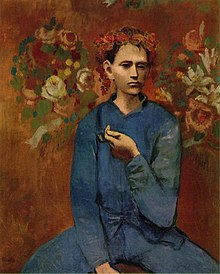
Pablo Picasso, 1905, Garçon à la pipe, (Boy with a Pipe), private collection, Rose Period
Several paintings by Picasso rank among the most expensive paintings in the world. Garçon à la pipe sold for US$104 million at Sotheby’s on 4 May 2004, establishing a new price record. Dora Maar au Chat sold for US$95.2 million at Sotheby’s on 3 May 2006.[103] On 4 May 2010, Nude, Green Leaves and Bust was sold at Christie’s for $106.5 million. The 1932 work, which depicts Picasso’s mistress Marie-Thérèse Walter reclining and as a bust, was in the personal collection of Los Angeles philanthropist Frances Lasker Brody, who died in November 2009.[104] On 11 May 2015 his painting Women of Algiers set the record for the highest price ever paid for a painting when it sold for US$179.3 million at Christie’s in New York.[105]
On 21 June 2016, a painting by Pablo Picasso titled Femme Assise (1909) sold for £43.2 million ($63.4 million) at Sotheby’s London, exceeding the estimate by nearly $20 million, setting a world record for the highest price ever paid at auction for a Cubist work.[106][107]
On 17 May 2017, The Jerusalem Post in an article titled “Picasso Work Stolen By Nazis Sells for $45 Million at Auction” reported the sale of a portrait painted by Picasso, the 1939 Femme assise, robe bleu, which was previously misappropriated during the early years of WWII. The painting has changed hands several times since its recovery, most recently through auction in May 2017 at Christie’s in New York City.[108]
In March 2018, his Femme au Béret et à la Robe Quadrillée (1937), a portrait of Marie-Thérèse Walter, sold for £49.8m at Sotheby’s in London.[109]
Personal life
Throughout his life Picasso maintained several mistresses in addition to his wife or primary partner. Picasso was married twice and had four children by three women:
- Paulo (4 February 1921 – 5 June 1975, Paul Joseph Picasso) – with Olga Khokhlova
- Maya (born 5 September 1935, Maria de la Concepcion Picasso) – with Marie-Thérèse Walter
- Claude (born 15 May 1947, Claude Pierre Pablo Picasso) – with Françoise Gilot
- Paloma (born 19 April 1949, Anne Paloma Picasso) – with Françoise Gilot
Photographer and painter Dora Maar was also a constant companion and lover of Picasso. The two were closest in the late 1930s and early 1940s, and it was Maar who documented the painting of Guernica.
The women in Picasso’s life played an important role in the emotional and erotic aspects of his creative expression, and the tumultuous nature of these relationships has been considered vital to his artistic process. Many of these women functioned as muses for him, and their inclusion in his extensive oeuvre granted them a place in art history. [110] A largely recurring motif in his body of work is the female form. The variations in his relationships informed and collided with his progression of style throughout his career. For example, portraits created of his first wife, Olga, were rendered in a naturalistic style during his Neoclassical period. His relationship with Marie-Thérèse Walter inspired many of his surrealist pieces, as well as what is referred to as his “Year of Wonders.” [111] An early lover, Fernande Olivier, may have inspired the switch from his “Blue Period” to his “Rose Period.” [112]
Picasso has been commonly characterised as a womaniser and a misogynist, being quoted as having said to one of his mistresses, François Gilot, “Women are machines for suffering.” [113] He later told her, “For me there are only two kinds of women: goddesses and doormats.” [114] In her memoir, Picasso, My Grandfather, Marina Picasso writes of his treatment of women, “He submitted them to his animal sexuality, tamed them, bewitched them, ingested them, and crushed them onto his canvas. After he had spent many nights extracting their essence, once they were bled dry, he would dispose of them.” [115]
Of the several important women in his life, two, Marie-Thèrése Walter, a mistress, and Jacqueline Roque, his second wife, committed suicide. Others, notably his first wife Olga Khokhlova, and his mistress Dora Maar, succumbed to nervous breakdowns. His son, Paulo, developed a fatal alcoholism due to depression. His grandson, Pablito, also committed suicide when he was barred by Jacqueline Roque from attending the artist’s funeral. [113]
Catalogue raisonné
Picasso entrusted Christian Zervos to constitute the catalogue raisonné of his work (painted and drawn). The first volume of the catalog, Works from 1895 to 1906, published in 1932, entailed the financial ruin of Zervos, self-publishing under the name Cahiers d’art, forcing him to sell part of his art collection at auction to avoid bankruptcy.[116][117]
From 1932 to 1978, Zervos constituted the catalogue raisonné of the complete works of Picasso in the company of the artist who had become one of his friends in 1924. Following the death of Zervos, Mila Gagarin supervised the publication of 11 additional volumes from 1970 to 1978.[118]
The 33 volumes cover the entire work from 1895 to 1972, with close to 16,000 black and white photographs, in accord with the will of the artist.[119]
- 1932: tome I, Œuvres de 1895 à 1906. Introduction p. XI–[XXXXIX], 185 pages, 384 reproductions
- 1942: tome II, vol.1, Œuvres de 1906 à 1912. Introduction p. XI–[LV], 172 pages, 360 reproductions
- 1944: tome II, vol.2, Œuvres de 1912 à 1917. Introduction p. IX–[LXX–VIII], 233 p. pp. 173 to 406, 604 reproductions
- 1949: tome III, Œuvres de 1917 à 1919. Introduction p. IX–[XIII], 152 pages, 465 reproductions
- 1951: tome IV, Œuvres de 1920 à 1922. Introduction p. VII–[XIV], 192 pages, 455 reproductions
- 1952: tome V, Œuvres de 1923 à 1925. Introduction p. IX–[XIV], 188 pages, 466 reproductions
- 1954: tome VI, Supplément aux tomes I à V. Sans introduction, 176 pages, 1481 reproductions
- 1955: tome VII, Œuvres de 1926 à 1932. Introduction p. V–[VII], 184 pages, 424 reproductions
- 1978: Catalogue raisonné des œuvres de Pablo Picasso, Paris, éditions Cahiers d’art[120]
Further publications by Zervos
- Picasso. Œuvres de 1920 à 1926, Cahiers d’art, Paris
- Dessins de Picasso 1892–1948, Paris, éditions Cahiers d’art, 1949
- Picasso. Dessins (1892–1948), Hazan, 199 reproductions, 1949
ــــــــــــــــــــــــــــــــــ
گرنيكا (لوحة)
| گرنيكا | |
|---|---|
 |
|
| الفنان | پابلو پيكاسو |
| السنة | 1937 |
| النوع | زيت على كنڤاه |
| الموقع | Museo Reina Sofia، مدريد |
گرنيكا هي لوحة جدارية للفنان پابلو پيكاسو استوحاها من قصف گرنيكا، الباسك حين قامت طائرت حربية ألمانية وإيطالية مساندة لقوات القوميين الإسپان بقصف المدينة في 26 أبريل 1937 بغرض الترويع خلال الحرب الأهلية الإسپانية [1] وكانت حكومة الجمهورية الإسبانية الثانية (1931-1939) قد كلفت بابلو بيكاسو بابداع لوحة جدارية لتعرض في الجناح الإسباني في المعرض الدولي للتقنيات والفنون في الحياة المعاصرة “Exposition Internationale des Arts et Techniques dans la Vie Moderne” الذي أقيم في باريس عام 1937.
وكان بيكاسو قد انتهى من اللوحة في أواسط يونيو 1937.[2]
گرنيكا تعرض مأساة الحرب والمعاناة التي تسببها للأفراد، وقد صارت معلماً أثرياً، لتصبح مذكراً دائماً بمآسي الحروب، إضافة لاعتبارها رمزا مضاداً للحرب وتجسيداً للسلام. بعد الانتهاء منها طافت اللوحة في جولة عالمية موجزة العالم لتصبح من اللوحات الأكثر شهرة كما أن جولتها تلك ساهمت في لفت أنظار العالم للحرب الأهلية الإسبانية.
اللوحة تمت بأسلوب التصوير الزيتي تتكون من الألوان الأزرق الداكن، الأسود والأبيض بطول يبلغ 3.5 أمتار وعرض يبلغ 7.8 أمتار. وهي معروضة في متحف مركز الملكة صوفيا الوطني للفنون “Museo Nacional Centro de Arte Reina Sofía” في مدريد.

پابلو پیکاسو
| پابلو پیکاسو | |
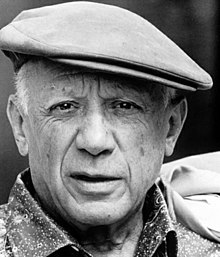 |
|
| نام اصلی | پابلو پیکاسو |
| زادهٔ | ۲۵ اکتبر ۱۸۸۱ مالاگا، اسپانیا |
| درگذشت | ۸ آوریل ۱۹۷۳ (۹۱ سال) موژَن، فرانسه |
| جایگاه خاکسپاری | Château of Vauvenargues |
| ملّیت | اسپانیایی |
| رشته | نقاشی، رسم، مجسمهسازی، چاپ دستی، سفالگری، طراحی صحنه، نویسندگی |
| جنبش | کوبیسم |
| آثار برجسته | دوشیزگان آوینیون گرنیکا نقاش و مدلش زن گریان |
| امضا |  |
پابلو روییس ای پیکاسو (/pɪˈkɑːsoʊ, –ˈkæsoʊ/;[۱] اسپانیولی: [ˈpaβlo piˈkaso]) (زاده ۲۵ اکتبر ۱۸۸۱ – درگذشته ۸ آوریل ۱۹۷۳) نقاش، شاعر، طراح صحنه، پیکرتراش، گراورساز و سرامیک کار اسپانیایی و یکی از برترین و تأثیرگذارترین هنرمندان سده ۲۰ میلادی بود. او به همراه ژرژ براک، نقاش و پیکرتراش فرانسوی، سبک کوبیسم را پدیدآورد.[۲][۳] از جمله آثار مشهور او میتوان به دوشیزگان آوینیون و گرنیکا اشاره کرد. پیکاسو بیشتر عمر خود را در فرانسه به سر برد. او به دلیل جستجوگری، نوآوری، پرکاری و اثرگذاری بر معاصران، یکی از مهمترین هنرمندان سده بیستم بهشمار میآید.
دوره اولیه زندگی
وی در ۲۵ اکتبر سال ۱۸۸۱ در مالاگا، یکی از شهرهای کشور اسپانیا، زاده شده و با نام «پابلو دیهگو خوسه فرَنسیسکو د پائولا خوان رمدیوس ترینیداد روییس ای پیکاسو» غسل تعمید داده شد. او فرزند یک نقاش تحصیل کرده به نام جوز روییسبلنکو (Jose Ruis Blanco) و ماریاپیکاسو (Maria Picasso) بود[۴] که از سال ۱۹۰۱ نام خود را به نام خانوادگی مادرش تغییر داد. پابلو از همان دوران کودکی به نقاشی علاقه پیدا کرد و از ده سالگی نزد پدرش که معلم یک آموزشگاه هنری بود، اصول اولیهٔ نقاشی را فراگرفت و دوستانش را با کشیدن نقاشی بدون بلند کردن قلم یا نگاه کردن به کاغذ سرگرم میکرد.
در سال ۱۸۹۵ به همراه خانواده به بارسلونا تغییر مکان دادند[۵] و پیکاسو در آنجا در آکادمی هنرهای عالی به نام لالُنخا (La Lonja) به تحصیل مشغول شد. در اوایل کار، دیدار او از مکانها و گروههای مختلف هنری تا سال ۱۸۹۹ در پیشرفت هنریش بسیار تأثیرگذار بود. وی تحصیلات خود را در فرانسه به پایان رساند. او نزد پدرش که استاد نقاشی بود به آموختن پرترهنگاری پرداخت و در سال ۱۹۰۳ مقیم پاریس شد. در سالهای ۱۹۰۶ و ۱۹۱۰، به اتفاق ژرژ براک مکتب کوبیسم را پایهگذاری کرد. ژرژ براک، از نخستین کسانی بود که سنجاق و میخ را با هم توأم نمود و پیکاسو تخته و چیزهای دیگری را هم به آن افزود. پیکاسو در سبک خود شهرت فراوانی به دست آورد و پیروان فراوانی کسب نمود.
آغاز فعالیت هنری
دوره آبی
پیکاسو زمانی که به کار مشغول نبود، از تنها ماندن خودداری میکرد و به همین دلیل در مدت کوتاهی حلقهٔ دوستانش که شامل گیوم آپولینر، ماکس ژاکوب و لئواستاین و همچنین دو دلال بسیار خوب به نامهای امبروز (Amborise Vollard) و برسول (Berthe Weel) بود، شکل گرفت. در این زمان خودکشی یکی از دوستانش به روی پابلوی جوان تأثیر عمیقی گذاشت و تحت چنین شرایطی دست به خلق آثاری زد که از آن به عنوان دورهٔ آبی یاد میکنند. در این دوره بیشتر به ترسیم چهرهٔ آکروباتها، بندبازان، گدایان و هنرمندان میپرداخت و در طول روز در پاریس به تحقیق بر روی شاهکارهایش در لوور و شبها به همراه هنرمندان دیگر در میکدهها مشغول میشد. پابلو پیکاسو در دورهٔ آبی بیشتر رنگهای تیره را در تابلوهای نقاشی خود به کار میگرفت.[۶]
در دورههای آبی و گلفام استقلال هنری اش را بروز داد. اوضاع بحرانی اروپا، جنگ داخلی اسپانیا و اشغال فرانسه توسط آلمانیها، بر موضوع و محتوای هنر او اثری عمیق گذاشت و عناصر اساطیری و نمادین در آثارش رخ نمودند. تابلوی گرنیکا نمونه شاخص هنر تمثیلی او در این دورهاست. او با بهرهگیری از هنر بدوی (مجسمههای کهن ایبریایی، و صورتکها و تندیسهای آفریقایی)، در راهی تازه قدم گذارد. شاید پیکاسو طراحی را برترین وسیله برای انتقال بیواسطه قدرت ابداع خود میدانست. طراحیهای دوره جوانی اش به دور از طبیعتگرایی و بری از هرگونه رونگاری، بر اثر تجربه تجسمی به روی کاغذ ترسیم شدهاند.
پیکاسو دورههای هنری مختلف را گذراند که کمترین هنرمندی به چنین تجربهٔ عظیمی دست پیدا میکند. یکی از مهمترین دورهٔ کاری پیکاسو چنانکه پیش از این گفتهشد، دورهٔ آبی بود. با وجود اینکه تعهدات کاری در فرانسهٔ اواخر قرن نوزدهم و اوایل هنر قرن بیستم کمتر شده بود شاید هیچ هنرمندی به اندازهٔ پیکاسو در تعهد کاری خود، تلخی زندگی را آنقدر بزرگ نمایش نداد. این تلخی منحصراً در دورهٔ آبی (۱۹۰۴–۱۹۰۱) به اوج خود رسید چنانکه از مجموعهٔ رنگهای مالیخولیایی آن دوره با سایه روشن آبی و حاشیهٔ تاریک آن بر میآید بدون شک زندگی در فقر خانوادگی در زمان جوانی در سالهای اولیهٔ زندگیش در پاریس و برخورد با کارگران و گدایان اطراف خود درکشیدن پرترهٔ شخصیتها با حساسیت و احساس ترحم هر چه بیشتر نسبت به آنها تأثیر زیادی گذاشتهاست. زن اطوکش (Woman Ironing) در پایان دورهٔ آبی با رنگهای روشنتر اما هنوز با طرح غم افزای شامل سفید و خاکستری تصور اصلی فرسودگی و رنج پیکاسو را نشان میدهد. اگر چه واقعیت اقتصادی و اجتماعی در پاریس آن دوره ریشه کرده بود. رفتار دوستانهٔ این هنرمند در این مورد که با خطوط زاویهدار و متقارن، دین هنری خود را با ترکیب خطوط امتداد داده شده و ظریف که با نفوذ به حقایق تجربی مورخ معروف ال گرکو به آنها رسیده بود، نمایش میداد و پیکاسو در آنجا این موضوع را با حضور تقریباً معنوی و خیالی از آن زن به عنوان مثالی از فقر و بدبختی آن دوره نشان دادهاست.
دوره رز
در سال ۱۹۰۰ میلادی اولین نمایشگاه پیکاسو در بارسلونا تشکیل شد. در پاییز همان سال به پاریس رفت تا در آنجا مطالعاتی در ابتدای قرن جدید داشته باشد و در آوریل ۱۹۰۴ در پاریس اقامت کرد و در آنجا به وسیلهٔ آثار امپرسیونیست خود به شهرت رسید. اما پس از مدت کوتاهی اقامت در فرانسه با تغییر ارتباطات، جعبهٔ رنگ او به رنگهای قرمز و صورتی تغییر پیدا کرد. به همین دلیل به این دوره دوران صورتی پیکاسو میگویند. در این دوران پس از دوستی با برخی از دلالان هنر، شاعر آن زمان ماکس ژاکوب و نویسندهٔ تبعیدی آمریکایی، گرترود استاین و برادرش لئو که اولین حامیان او بودند، سبک او بهطور محسوسی عوض شد بهطوریکه تغییرات درونی او در آثارش نمایان است؛ و تغییر سبک او از دورهٔ آبی به دورهٔ رز در اثر مهم او به نام دوشیزگان آوینیون نمونهای از آن است.
هنر مدرن تغییرشکل یافته

تابلوی دوشیزگان آوینیون اثر پیکاسو در سال ۱۹۰۷
دوره آفریقایی
کار پابلو پیکاسو در تابستان سال ۱۹۰۶، وارد مرحلهٔ جدیدی شد که نشان از تأثیر هنر یونان شبه جزیرهٔ ایبری و آفریقا بر روی او بود که به این ترتیب سبک را به وجود آورد که توسط منتقدین نقاش معاصر مورد توجه قرار نگرفت.

تابلوی دن کیشوت اثر پیکاسو در سال ۱۹۵۵
کوبیسم
در سال ۱۹۰۸ پابلو پیکاسو و نقاش فرانسوی ژرژ براک متأثر از قالب امپرسیونیسم فرانسوی سبک جدیدی را درکشیدن مناظر به کار بردند که از نظر چندین منتقد از مکعبهای کوچکی تشکیل شدهاست. این سبک کوبیسم نام گرفت و بعضی از نقاشیهای این دو هنرمند در این زمینه آنقدر به هم شبیه هستند که تفکیک آنها بسیار مشکل است. سیر تکاملی بعدی پابلو در کوبیسم از نگاه تحلیلی (۱۱–۱۹۰۸) به منظر ساختگی و ترکیبی که آغاز آن در سالهای ۱۳–۱۹۱۲. بود ادامه داشت در این شیوه رنگهای نمایش داده شده به صورت صاف و چند تکه، نقش بزرگی را ایفا میکند و بعد از این سالها پیکاسو همکاری خود را در بالت و تولیدات تئاتر و نمایش در سال ۱۹۱۶ آغاز کرد و کمی بعد از آن آثار نقاشی خود را با سبک نئوکلاسیک و نمایش تشبیهی عرضه کرد. این نقاش بزرگ در سال ۱۹۱۸ با الگا (Olgo)، رقاص بالت ازدواج کرد و در پاریس به زندگی خود ادامه داد و تابستانهایش را نیز در کنار ساحل دریا سپری میکرد. از سال ۱۹۲۵ تا ۱۹۳۰ درگیر اختلاف عقیده با سوررئالیستها بود و در پاییز سال ۱۹۳۱ علاقهمند به مجسمهسازی شد و با ایجاد نمایشگاههای بزرگی در پاریس و زوریخ و انتشار اولین کتابش به شهرت فراوانی رسید.
توجه پیکاسو در مدت کوتاهی از کشیدن نقاشیهایی با کنایهٔ اجتماعی و مذهبی به سوی تحقیق در فضای دیگر و خلق آثاری برد که اوج آن در مکتب کوبیسم به ثمر رسید. پرترهٔ فرناند با روسری زنانهٔ سیاه (Fernande with a black Montilla) اثری در این مرحلهٔ کاری است. خیالی بودن تصویر با رنگبندی مناسب و ضربههای قلم موی پرنشاط نشان از معشوقهٔ او فرناند الیور (Fernonde Oliver) میدهد که روسری به سر کرد، و سمبل هنر اسپانیایی او است. از ایجاد سبک شمایلی از صورت او با مشخصات خلاصه شده میتوان افزایش علاقهٔ پیکاسو را در خلاصه کردن ویژگیها و استحکام پیکرتراشی پیشگویی کرد که این تأثیر را در آثار بعدی او میبینیم.
جنگ اسپانیا، جنگ جهانی دوم و پس از آن

تابلوی گرنیکا اثر پیکاسو به سال ۱۹۳۷

تابلوی دورا مار و گربه خلق شده در سال ۱۹۴۱
در سال ۱۹۳۶ جنگ داخلی اسپانیا شروع شد که تأثیر زیادی به روی پیکاسو گذاشت بهطوریکه تأثیر آن را میتوان در تابلوی گرنیکا (۱۹۳۷) دید. در این پردهٔ نقاشی بزرگ، بیعاطفگی، وحشیگری و نومیدی حاصل از جنگ به تصویر کشیده شدهاست. پابلو اصرار داشت که این تابلو تا زمانی که دموکراسیـ کشور اسپانیا به حالت اول برنگردد به آنجا برده نشود. این تابلوی نقاشی به عنوان یکی از پرجاذبهترین آثار در موزهٔ مادرید سال ۱۹۹۲ در معرض نمایش قرار گرفت.
حقیقت این است که پیکاسو در طول جنگ داخلی اسپانیا، جنگ جهانی اول و دوم کاملاً بیطرف بود از جنگیدن با هر طرف یا کشوری مخالفت میکرد. او هرگز در این مورد توضیحی نداد. شاید این تصور به وجود آید که او انسان صلحطلبی بود اما تعدادی از هم عصران او از جمله براک بر این باور بودند که این بیطرفی از بزدلیاش ناشی میشد. به عنوان یک شهروند اسپانیایی مقیم پاریس هیچ اجباری برای او نبود که در مقابل آلمان در جنگ جهانی مبارزه کند یا در جنگ داخلی اسپانیا، خدمت برای اسپانیاییهای خارج از کشور کاملاً اختیاری بود و با وجود اظهار عصبانیت پیکاسو نسبت به فاشیست در آثارش، هرگز در مقابل دشمن دست به اسلحه نبرد. او با وجود کنارهگیری از جنبش استقلالطلبی در ایام جوانیش حمایت کلی خود را از چنین اعمالی بیان میکرد و بعد از جنگ جهانی دوم به گروه کمونیست فرانسه پیوست و حتی در مذاکرهٔ دوستانهٔ بینالمللی در لهستان نیز شرکت کرد اما نقد ادبی گروهی از رئالیستها در مورد پرترهٔ استالین، علاقهٔ پیکاسو را به امور سیاسی کمونیستی سرد کرد.
آثار متاخر

تابلوی نقاش و مدلش خلق شده در سال ۱۹۲۷. این تابلو در موزه هنرهای معاصر تهران نگهداری میشود.

تابلوی رویا خلق شده در سال ۱۹۳۲
پیکاسو در سال ۱۹۴۰ به یک گروه مردمی ملحق شد و شمار زیادی از نمایشگاههای پیکاسو در طول زندگی این هنرمند در سالهای بعد از آن برگزار شد که مهمترین آنها در موزهٔ هنر مدرن نیویورک در سال ۱۹۳۹ و در پاریس در سال ۱۹۵۵ ایجاد شد. در ۱۹۶۱، این نقاش اسپانیایی با ژاکلین روک (Jacqueline Roque) ازدواج کرد و به موگینس نقل مکان کرد. پابلو پیکاسو در آنجا خلق آثار با ارزش خود همانند نقاشی، طراحی، عکسهای چاپی، سفالگری و مجسمهسازی را تا زمان مرگش یعنی هشتم آوریل سال ۱۹۷۳ در موگینس فرانسه ادامه داد.
در سالهای هشتاد یا نود سالگی، انرژی همیشگی دوران جوانیش بسیار کمتر شده بود و بیشتر خلوت میگزید. همسر دوم او ژاکلین روک به جز مهمترین ملاقات کنندگانش و دو فرزند پیکاسو، کلاد و پالوما (Claude and Paloma) و دوست نقاش سابقش، فرانسواز ژیلو به کس دیگر اجازهٔ ملاقات با او را نمیداد. گوشهگیری پابلو پیکاسو بعد از عمل جراحی پروستات در سال ۱۹۶۵ بیشتر شد و با اختصاص دادن تمام نیرویش به کار، درکشیدن تابلو جسورتر گشت و از سال ۱۹۶۸ تا سال ۱۹۷۱ سیل عظیم نقاشیهایش و صدها قلمزنی بشقاب مسی در معرض دید عموم قرار گرفت. این آثارش در این زمان توسط بسیاری از رویاپردازان نادیده گرفته شد بهطوریکه داگلاس کوپر، آثار پایانی او را به عنوان آثار یک پیرمرد عصبانی در اتاق مرگ نامید. پیکاسو همچنین مجموعهای قابل توجه از آثار دیگر نقاشان معروف هم دورهٔ خود مانند آنری ماتیس را نگهداری میکرد و چون هیچ وصیتنامهای در زمان مرگش نبود به عنوان مالیات ایالتی فرانسه، بعضی از آثار و مجموعههای او به دولت داده شد.
این نقاش و مجسمهساز اسپانیایی با خلق آثارش گام مهمی در هنر مدرن برداشت. او در ابداع و نوآوری سبکها و تکنیکهای نقاشی بینظیر بود و استعداد خدادادی او به عنوان یک نقاش و طراح بسیار قابل اهمیت است. او در کار کردن با رنگ روغن، آبرنگ، پاستل، زغال چوب، مداد و جوهر بسیار توانا بود و با ایجاد آثاری در مکتب کوبیسم استعداد بینظیر خود را به بهترین شکل به کار گرفت و با وجود آموزش محدود علمی (که تنها یک سال از دورهٔ تحصیلاتی را در آکادمی رویال مادرید به پایان رساند) تلاش هنرمندانهای را در تغییر جهت فکری خود انجام داد. از پابلو پیکاسو به عنوان پرکارترین نقاش تاریخ یاد میشود. در حالیکه دوستانش به او توصیه میکردند که در سن هفتاد و هشت سالگی دست از کار بردارد اما او مخالفت میکرد. مرگ او در حالی به وقوع پیوست که با تعداد زیادی تابلو و آثار ارزشمند، مرکب از علائق شخصی و به دور از در نظر گرفتن بازار هنر یک ثروتمند محسوب میشد؛ و اخیراً در سال ۲۰۰۳ خویشاوندان پیکاسو موزهٔ وقف شدهای را در زادگاه پیکاسو یعنی مالاگا به نام موسیوپیکاسومالاگا راه انداختند.
مرگ
وی در ۸ آوریل ۱۹۷۳، در حالی به اتفاق همسرش ژاکلین روک دوستانشان رو برای صرف شام پذیرایی میکردند بر اثر حمله قلبی درگذشت. ژاکلین روک که پس از پیکاسو شدیداً از نظر روحی دگرگون شده بود، در سال ۱۹۸۶، با شلیک گلوله خودکشی کرد.[۷]
سبک و تکنیک

تابلوی دختری با لباس خواب خلق شده در سال ۱۹۰۵ در دوره موسوم به دوره آبی

تابلوی پسری با پیپ خلق شده توسط پیکاسو در سال ۱۹۰۷ در دوره موسوم به دوره رز یا سرخ
او در مجسمهسازی، حکاکی روی چوب، سفالگری، سرامیک، چاپ سنگی (لیتوگرافی) و معماری تبحر داشت. او مکتب کوبیسم را به همراه ژرژ براک در میان نقاشان جا انداخت و فن اختلاط رنگ بر پردهٔ نقاشی را به عالم هنر معرفی کرد. پیکاسو علاقه خاصی به زنها داشت و غیر از اینکه در زندگی غرق آنها بود تا مدتها نقاشیهای وی مشخصاً تنها راجع به زنها بود؛ و دوره اول هنری وی در طبقهبندیها بنامهای Blue & Rose است. در دوران آبی سبک کاری وی اغلب شامل سایههای آبی کشیده شده از اجسامی بود که تنها به نیمی از آنها به تصویر کشیده میشد. در دوران رز از آبی به سمت صورتی تمایل پیدا کرد و نقاشیهای وی به دنیای واقعی نزدیکتر شدند. او سپس به سبک کوبیسم روی آورد که در آن اشیا را توسط اشکال ساده هندسی به تصویر کشاند.[۸]
آخرین دوره کاری پیکاسو دوره سورئالیستی است که از ۱۹۲۴ آغاز میشود؛ ولی همیشه فاصله اش را با سورئالیستها حفظ کرد. پیکاسو و هنرمندان سورئالیست جهان در اصول بنیادی، بدین معنا که هنر قادر است آنچه را که طبیعت و عقل نمیتوانند ابراز کنند نشان دهد، موافقت داشتند ولی اختلاف اساسی بسیاری بین پیکاسو و سورئالیستها وجود دارد: به عقیده آنها، پیکاسو به دنیای خارج و مضمون وابستگی بسیار دارد و از دنیای اوهام و رؤیاها بسیار دور است.[۹]
معشوقهها و دوستدختران وی از جمله فرانسیس گیلوت،[۱۰] ماری ترزا والترز[۱۱] و ژنویو لاپورت[۱۲] موضوع اثرهای هنری وی بودند و نقش مهمی را در خلق برخی از بهترین آثار پیکاسو داشتند. کوبیسم در سالهای تعیینکنندهٔ ۱۴–۱۹۰۷ به عنوان جدیدترین و بانفوذترین سبک هنری قرن بیستم بسیار مورد توجه قرار گرفت و وسعت پیدا کرد. زمان قطعی توسعهٔ آن در طول تابستان ۱۹۱۱ اتفاق افتاد. همان موقعی که پابلو پیکاسو و جرجیس براک پا به پای هم به این سبک نقاشی میکردند. تنگ، کوزه و کاسهٔ میوه (Carafe, Jug and Fiuit Boul) مراحل اولیهٔ این سبک نقاشی پیکاسو را نشان میدهد. سطوح آن با صراحت به چند قسمت تقسیم شده اما با این وجود بهطور پیچیدهای چند تکه نشدند. از نظر شکل و قالب تودهای از خیال و وهم را در خود نگهداشته و با وجود اینکه از وجهٔ دراماتیکی آن کاسته شدهاست، اما قابل چشمپوشی نیست. در سیر تحولی این سبک، براک و پیکاسو کوبیسم تحلیلی را تقریباً در موضوع اختلال حواس کامل به وجود آوردند که در بین آثار پیکاسو ارگزن (Accordionist) ترکیب گیجکنندهای از این نوع بود.
چندی بعد پیکاسو مرگ کوبیسم را با یادگاری زندگی آرام ماندولین و گیتار (Mondolin and Guitar) در طول مهمانی شبنشینی در پاریس در حضور شرکتکنندگان که فریاد میزدند «پیکاسو در میدان رقابت مرد» اعلام کرد. این مهمانی در آخر شب با یک شورش و آشوب به پایان رسید و تنها با ورود پلیس فرونشانده شد. سری تابلوهای رنگآمیزی شدهٔ بعدی پیکاسو در سبک کوبیسم با ترکیبی شجاعانه در شکلهای به هم پیوسته چنین قضاوتی را بیاعتبار میکند و در پایان از روش تکنیکی کارش به دفاع میپردازد. اما هنرمند حقیقتاً در پی احیای کشفیات قبلی خود نبود. واضح است که تصاویر بنیانی و نماهای اشباع شده گواهی به قدردانی او از پیشرفت همزمان در نقاشی سورئالیست میدهد که مخصوصاً این تأثیر از آثار آندره ماسون و خوان میرو (Joan Miro) برخاسته است.
بعد از نمایش قطعهای از موضوع خاموشسازی و کاهش نور در ۱۹۱۱، در سالهای بعد پیکاسو و براک تصورات ذهنی بیشتری را در نقاشیهای خود به کار بردند که معمولاً از محیط هنرکدهها و کافهها گرفته میشد و بدون کنار گذاشتن شیوههای کوبیسم تحلیلی، شیوهٔ جدیدی را توسعه دادند که به کوبیسم ترکیبی از آن نام برده میشد. در این نوع سبک ترکیباتی را با رنگهای متنوع و بهطور وسیعتر به وجود آوردند و در تابستان سال ۱۹۱۲، براک اولین مقوایی را که چسب و گلرس و چیزهای دیگر را به آن میچسبانند ساخت و پیکاسو نیز در تابلوی «پیپ، گیلاس جام و عرق ویوکس» (Pipe, Glass, Bottle of vieux Marc) از همین شیوه پیروی کرد و کدری رنگهای کارهای قبلی او از بین رفت و شفاف شد و شفافیت این مورد با نشان دادن قسمتهایی از گیتار در پشت گیلاس نشان داده شدهاست و نیز مطمئناً فضایی را بین دیوار و صفحهٔ تصویر اشغال میکند و موقعیتهای نسبی در تابلو کاملاً دو معنایی هستند.
از سال ۱۹۲۷ تا سال ۱۹۲۹ پابلو پیکاسو در فعالیت هنری خود از میان روشهای کاری خود استقلال خود را بهطور استادانهای در آثارش به دست آورد و در دنبالهٔ کارهای گوناگون بهترین مثال موجود، تابلوی کارگاه هنری (The Studio) (۲۸–۱۹۲۷) است که به سبک کوبیسم ترکیبی به تصویر کشیده شدهاست که به اجرای مقتدر و برجسته تبدیل شدهاست تقابل خطوط با قواعد هندسی مشخص پیکر مجسمههای آن زمان پیکاسو را تداعی میکند. تصاویر در «کارگاه هنری» میتواند با مجسمهٔ نیمتنه در سمت چپ و پرترهٔ تمام قد در سمت راست به شکل ابتکاری بسیار عالی قابل تشخیص باشد او به میل بینندگان برای اعتقاد به حقیقت اشیای نمایش داده شده تکیه میکند و مجسمهٔ نیمتنه در این تابلو که سه چشم دارد ممکن است ویژگیهای شخصیتی پیکاسو را در اثر هنری خود منعکس سازد. مطلبی که میتوان از روی این تابلوهای پرارزش فهمید این است که اثر متقابل حقیقت و خیال، دغدغهٔ مهمی در تمام طول زندگی پیکاسو بود.


كلمات خالدة للفنان الاسپاني پابلو پيكاسو (Pablo Picasso) 1973-1881
منقول
—————————————————–
• أنا أرسم ما يخالج عقلي، وليس ما تراه عینای.
• من يحاول ان يفهم اللوحات الفنية كمن يحاول ان يفهم تغريد الطيور.
• الفن لا يمثل الحقيقة! بل هو الكذبة الكبرى التي تمكننا من رؤية الحقيقة.
• الفن يغسل الروح من أدران الحياة اليومية.
• الواقعي هو كل شيء نستطيع ان نتخيله.
• المنتحل هو الذي يسرق من فنان واحد، والفنان الحقيقي هو الذي يتعلم من كل الفنانين.
• عليك ان تتعلم قواعد اللعبة كمحترف لكي يكون بإمكانك ان تخرقها كفنان.
• الآخرون يرون الأشياء ويتساءلون عنها. أما أنا فأرى ما يمكن ان تكون الأشياء واتساءل: لِمَ لا؟
• الالهام يزورني دون ان ادعوه! كل الذي افعله هو ان اباشر بالعمل بما يرضيه.
• بعض الرسامين يحولون الشمس الى مجرد دائرة صفراء! لكن العبرة هي ان تحول دائرة صفراء الى شمس ساطعة.
• هناك فنان في مخيلة كل طفل. المعضلة هي ان يبقى الفنان فیها عندما يكبر الطفل.
• أحاول باستمرار ان اعمل ما لا أستطيع عمله من أجل ان اتعلم كيفية عمل ذلك.
• من أجل رسم عمل أصيل ينبغي على الرسام ان لا ينشغل كثيرا بما يرسم.
• في النصف الأول من الحياة، يتعلم المرء كيف أن يكون بالغا، وفي النصف الثاني يتعلم كيف أن يكون طفلا.
• بدون عزلة طويلة، لا يمكن انتاج أي عمل رصين.
• الفنان الفاشل يستنسخ الآخرين أو يسرق منهم، والناجح يتعلم منهم.
• الرسم طريقة اخرى لكتابة المذكرات
• بعض الرسامين يحولون الشمس الى بقعة صفراء. و البعض الآخر يحولون البقعة الصفراء الى شمس
• سر الفن يكمن في ان تجد بدلا من ان تبحث
• كل طفل فنان…المشكلة هي كيف تظل فنان عندما تكبر
• نعرف جميعا ان الفن ليس حقيقة…انه كذبة تجعلنا ندرك الحقيقة .












